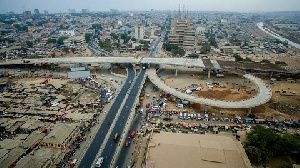Opinions of Thursday, 20 July 2017
Columnist: Dr Mark Bediako and Dr Nsiah-Acheampong
Cameras on our streets : A wake-up call after Lapaz shooting incident
On Wednesday, July 12, 2017, the news of daylight robbery was widely reported by the media with a subsequent deepening contagion by social media. This robbery led to the death of one police officer and left another in a critical condition as confirmed by the in charge of Police Public Affair Unit, Assistant Superintendent of Police (ASP) Afia Tenge.
The shooting incident which occurred in broad daylight provoked the authors’ thoughts about the effectiveness of security measures in the country, especially on our highways or urban roads. As a developing country, it will be beneficial to adopt certain appropriate and tested practices from developed countries.
In many of these developed countries, surveillance cameras are visibly mounted in public. They are even more pronounced at probable high-crime areas, major highways and cities. Security experts have reported on the benefits of surveillance cameras in fighting crime, some of which are deterrence of crime, scenario and activity monitoring, graphic evidence gathering, unequivocal decisions in dispute resolutions, generating evidence to help identify suspects and witnesses. The list is endless. It needs no further emphasis that security experts from most developed countries have pointed out that surveillance cameras are an effective crime control tool.
As our cities continue to develop and are becoming more complex, it will be correspondingly prudent to provide surveillance cameras to counteract crime and evolving crime by intimidation, dissuasion, decoy detection, persona and guise de-masking.
Recent developments in Ghana showed that some surveillance cameras were installed at major traffic intersections to check traffic offenders. That was good. However, this measure could be extended beyond traffic monitoring to crime monitoring on our highways. The Lapaz shooting incident creates a wake-up call for our government and city authorities to have a thought on this tool used to fight crime in developed countries.
It is gratifying to note that plans are underway to mount Police Observation Devices (PODs), a modern security system in Ghana by Virtual Security Africa, located in Accra. The POD technology, developed by Comdesco Group in Chicago, was first used in 2003 in a pilot security trial by the Chicago Police Department and found useful in the provision of video data primarily used as an after-the-fact forensic tool. Mr Malik Abass Daabu reiterated on Myjoyonline the relevance of PODs to the Bureau of National Investigations (BNI) in information gathering and the Motor Transport and Traffic Directorate (MTTD) in checking recklessness on our roads and introducing discipline to save lives and property.
The mounting of surveillance cameras has helped many high-crime cities in the world, including New York, Johannesburg and Egypt in the fight against crime. As a good tool to make our cities safe, it is recommended that the related government agencies such as the Ministries and the Metropolitan, Municipal and District Assemblies (MMDAs) take a conscious and proactive approach in mounting surveillance cameras on our highways, high-crime areas and some selected complex cities.
The authors, at this moment, would like to express their condolences to the bereaved family of the murdered police officer and pray for the speedy recovery of the wounded other.
The writers are Dr Mark Bediako (Senior Research Scientist, CSIR - Building and Road Research Institute) and Dr Nsiah-Acheampong (Research Scientist, CSIR - Building and Road Research Institute)
Entertainment










